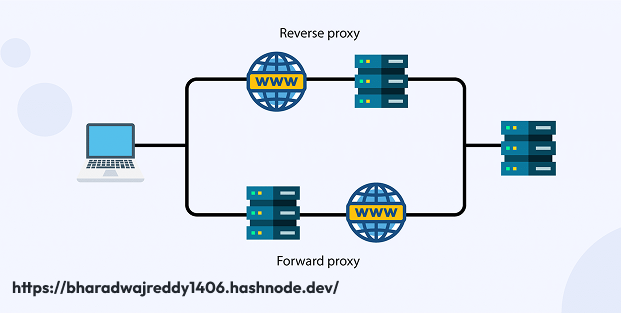Proxy Paradigms: Forward and Reverse Proxies
 Bharadwaj Reddy
Bharadwaj Reddy
Over the past few months, I’ve been diving deep into the world of DevOps—working with Docker, Jenkins, and GitHub Actions. Recently, I took a detour into networking, and I must say, the concept of proxies truly caught my attention. In today’s post, I’ll share my journey of understanding two types of proxies: the forward proxy and the reverse proxy. While both serve as intermediaries, their roles are distinctly different and essential in modern network security and load management.
What Is a Proxy?
At its core, a proxy is an intermediary that acts on behalf of another entity. In networking, this means handling requests between clients and servers or the Internet, offering layers of security and management in the process.
Forward Proxy: Shielding the Organization
Imagine an organization with several computers—say, A, B, C, D, E, and F—that need to access the Internet. If each computer were to send requests directly, they might inadvertently expose sensitive information like the organization’s IP addresses. This is where a forward proxy steps in.
How It Works: The forward proxy sits between the internal computers and the Internet. When any of these computers sends a request, the proxy intercepts it, forwards the request to the Internet, and then returns the fetched data back to the original computer.
Security Benefits: This setup prevents the direct exposure of the organization’s IP addresses. In doing so, it significantly reduces the risk of external threats—like hackers attempting to inject malware—compromising the entire network.
Reverse Proxy: Protecting the Server Farm
Now, let’s flip the script. A reverse proxy works on behalf of the server. Imagine you run a service hosted on multiple servers rather than a single machine. Directly exposing your server IPs to every incoming request isn’t ideal because it leaves you vulnerable to attacks such as DDoS.
How It Works: The reverse proxy stands in front of the server cluster. When a client sends a request, the reverse proxy handles it—often performing tasks like encryption, decryption, or load balancing—before forwarding it to one of the backend servers.
Security & Load Balancing: This not only hides the actual IP addresses of your servers but also distributes the load evenly, ensuring your service remains fast and reliable even under heavy traffic.
The Role of Nginx
One tool that has become synonymous with both proxy functions is Nginx. Known for its versatility, Nginx can act as:
A web server
A caching server
A forward or reverse proxy
A load balancer
Its multi-functional capabilities make it an indispensable tool in modern networking, capable of addressing various challenges efficiently and quickly.
Btw this Youtube video helped me a lot in understanding the concept to it’s core
https://www.youtube.com/watch?v=RXXRguaHZs0
I’d Highly recommend it
Subscribe to my newsletter
Read articles from Bharadwaj Reddy directly inside your inbox. Subscribe to the newsletter, and don't miss out.
Written by

Bharadwaj Reddy
Bharadwaj Reddy
Hey there! I’m Bharadwaj Reddy, currently an undergrad at Keshav Memorial Institute of Technology. I’m a full stack developer who loves building cool web applications with React, Node.js, and MongoDB. On top of that, I also love exploring machine learning with TensorFlow and PyTorch. I’m pretty comfortable navigating GitHub for version control and love tinkering with AWS for deploying projects. I post my regular learnings on Devops and other studies